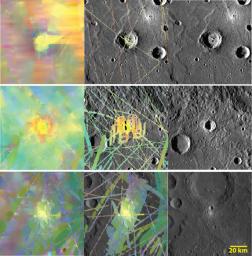The left column of images shows MASCS VIRS interpolated color composites of Kertesz (top), Dominici (middle),
and an unnamed crater (bottom). The middle column shows the VIRS color composite of spectral footprints, and the right column shows monochrome MDIS
images for the same areas. Yellow areas are highly reflective and thought to be relatively young, exhibiting fewer effects of space weathering. Kertesz and Dominici are also known to contain hollows, which are
shallow depressions with younger surfaces likely caused by the loss of volatiles.
The VIRS composite shows hundreds of individual footprints tracks
(minimum 100-200 m across and 3-4 km long) taken from different directions and altitudes. In locations where multiple footprints cover the same area, the
footprint with the best illumination for mineralogical interpretation (usually the lowest incidence angle where shadows are minimized) is used for making the
map. Where footprints are sparse, interpolation is required for full spatial coverage.
Date Created: July 28, 2014
Instruments:
Visible and Infrared Spectrograph (VIRS) of the Mercury Atmosphere and Surface Composition Spectrometer (MASCS) and Mercury Dual Imaging
System (MDIS)
VIRS Color Composite Wavelengths: 575 nm as red, 415 nm/750 nm as green, 310 nm/390 nm as blue
Center
Latitudes: 27.3° (top); 1.18° (middle); -3.6° (bottom)
Center Longitudes: 146.1° E (top); 323.5° E (middle); 60.9° E (bottom)
Resolution: 0.5 km/pixel
Scale: Kertesz crater (top) has a diameter of 32 km (20 mi.); Dominici crater (middle) has a diameter of
20 km (12 mi.)
The MESSENGER spacecraft is the first ever to orbit the planet Mercury, and the spacecraft's seven scientific instruments and radio science investigation are unraveling the history and
evolution of the Solar System's innermost planet. During the first two years of orbital operations, MESSENGER acquired over 150,000 images and extensive
other data sets. MESSENGER is capable of continuing orbital operations until early 2015.
For information regarding the use of images, see the
MESSENGER image use policy.

 Planetary Data System
Planetary Data System












